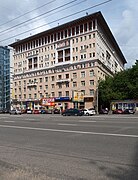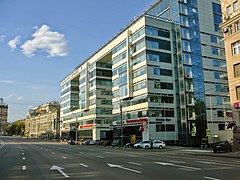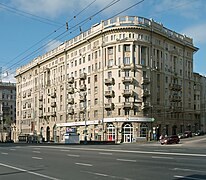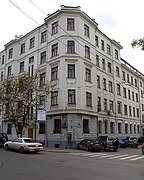Zemlyanoj whale
The Semljanoj Wal (Russian Земляной Вал ) is a street part of the Garden Ring in the Central Administrative District of Moscow . It leads from Zemlyanoj Wal Square to Taganskaya Square . With a length of 2.42 km, it is the largest section of the garden ring. The Zemlyanoj Wal crosses the Jausa River via the Vysokoyaussky Bridge, and the Nikolojamskaya Street via the Ulyanovskaya Elevated Road .
history
Semljanoi whale means a wall made of earth . This fortification was built around 1592/93 on the orders of Boris Godunov and existed until the end of the 18th or beginning of the 19th century. As early as the 18th century this was partially demolished and various wooden buildings were built on. This area was destroyed by the fire of Moscow in 1812, and according to a reconstruction plan in 1816 a new street with gardens was built here (Russian Сады, Sady ). Its part north of the Jausa was named Sadowaja-Semljanoi Wal , while the part south of the Jausa was Sadowaja-Semljanskaja . The Wysokojausski Bridge was built around 1873 (reconstructed in 1963). In 1935, Moscow began extensive reconstruction, including a reconstruction of the garden ring. Both sections were renamed Chkalovskaya Street in 1938 in honor of Valery Chkalov (from 1953 to 1994 Chkalova Street). The Tagansky Tunnel and Ulyanovskaya Elevated Road were built in the 1960s . In 1994 the street was named Zemlyanoj Wal. The architectural ensemble of the street consists of buildings from the 18th to the 21st century.
description
On the side with the odd house numbers are among others:
- House number 1/4 - a residential building from 1934 by the architect A. Kesler. The pathologist Alexei Abrikossow lived here from 1930 to 1940 , the physicist Igor Tamm from 1934 to 1953 , and the violinist Boris Goldstein .
- House numbers 5 and 7 - two apartment buildings from the beginning of the 20th century by the architect Ernst Nirnsee.
- House numbers 21 and 23 - two residential buildings from 1938. The scientist Zinovy Chukhanov , the mathematician Lev Schnirelman , the geologist Nikolai Shatsky , the astronomer Vasily Fezenkov and the aircraft designer Pavel Sukhoi lived here .
- House number 27, building 3 - a residential building from the 18th century.
- House number 35, building 1 - another residential building from the 18th century. In the 19th century it belonged to the merchant Pyotr Botkin. His son, the well-known doctor Sergei Botkin , was born here.
- House number 39, building 1 - a residential building from 1939–1953.
- House number 39, building 2 - the residential building was built in the 18th century on the site of a former manor house from the 1680s. In the 1820s it was built over again.
- House number 53 - Usachev Naydjonow mansion with a park. It was built by Domenico Gilardi , presumably with the help of Afanasi Grigoryev, on behalf of the merchant brothers W. and P. Usatschow 1829-1831. From the 1880s it was owned by the merchant Naidjonow. The Institute for Sports Medicine is now located here. The park area covers 8.2 hectares and is open to the public.
- House number 57/6 - Sakharov Center .
On the side with the even house numbers are among other things:
- House number 14-16 - a residential building from 1935 by A. Kesler. The painter Konstantin Juon , the pilot Valeri Tschkalow , the biologist Iwan Schmalhausen , the doctor Georgi Speranski, the children's writer Samuil Marschak and the actor Boris Tschirkow lived here.
- House number 30 - a residential building from the 19th century.
- House number 46 - the residential building for the MGB , built by the architect Evgeni Rybizki, a well-known symbol of Stalinist classicism. E. Rybizki was awarded the Stalin Prize in 1949, but after Stalin's death in 1955 the prize was withdrawn from him because of alleged “excesses in architecture”. Thereafter, Stalinist classicism came to an end in the USSR as part of the anti-Stalinist campaign initiated by Khrushchev.
- House number 44 - a five-storey residential building from 1911. In 1953, the renovation followed by adding another storey.
- House number 66 - a tenement house built by Ernst Nirnsee between 1910 and 1914.
- House number 76-78 - the Taganka Theater .
Web links
Individual evidence
- ↑ Decree of November 1955 "On the elimination of excesses in design and construction" on sovarch.ru (Russian architecture website)
Coordinates: 55 ° 45 ′ 0.3 ″ N , 37 ° 39 ′ 20.6 ″ E













